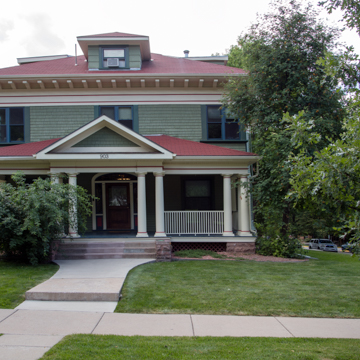U.S. Representative Edward T. Taylor fathered the Taylor Grazing Act, a major piece of New Deal legislation that reshaped the live-stock industry and much of the western landscape. The Taylor Act regulated live-stock grazing on public lands for the first
This overgrown four-square with third-story dormers and various bays is more important for its former occupant than its architecture. Numerous changes to the original design, as well as the addition of asbestos siding, have cheapened the house. The Colonial Revival front porch attempts elegance with its tri-clustered Tuscan columns and pilastered and pedimented entry, as does the elaborately carved foyer with its mahogany piers, brackets, spindles, and egg-and-dart trim. Far humbler cottages around Congressman Taylor's domicile include two vernacular Victorian cottages at 727 and 729 Bennett. A more polished four-square with a heavy Doric porch and Craftsman ornament is the B. T. Napier House (1912), 930 Bennett.





